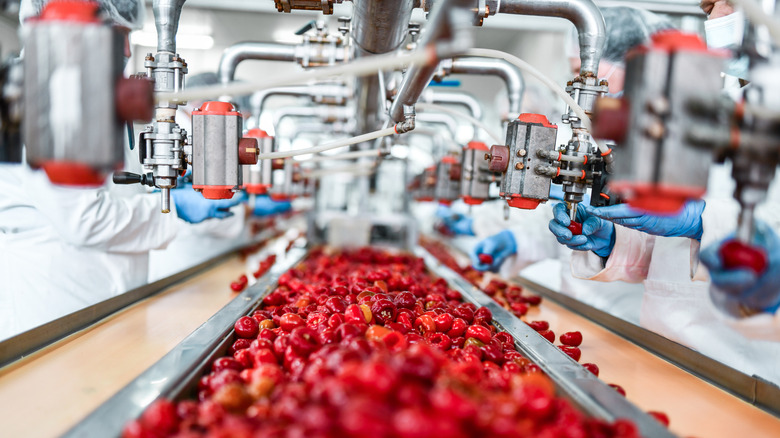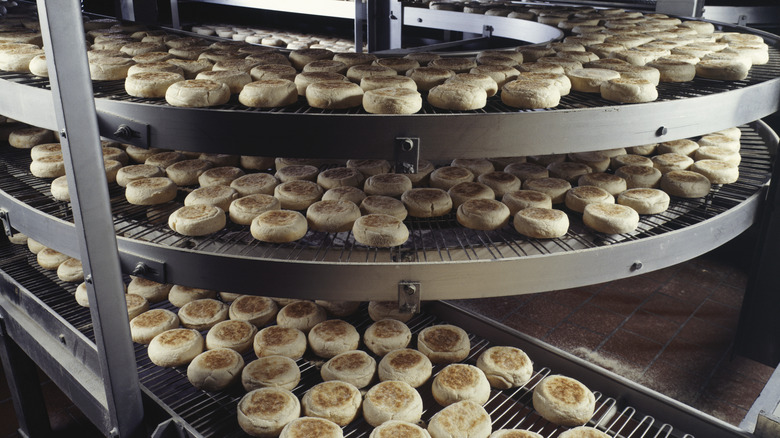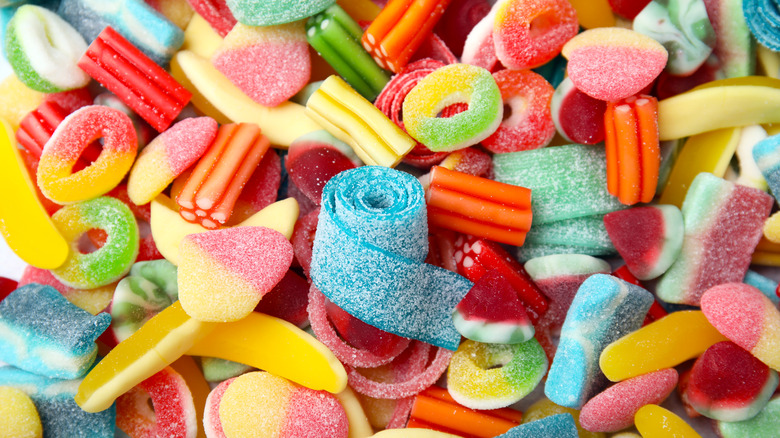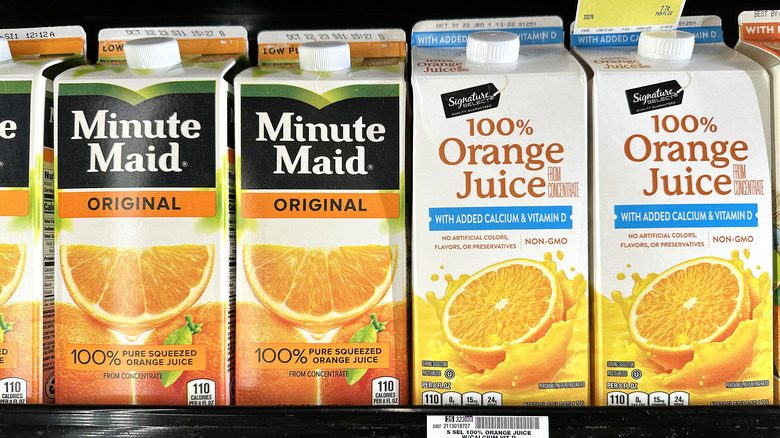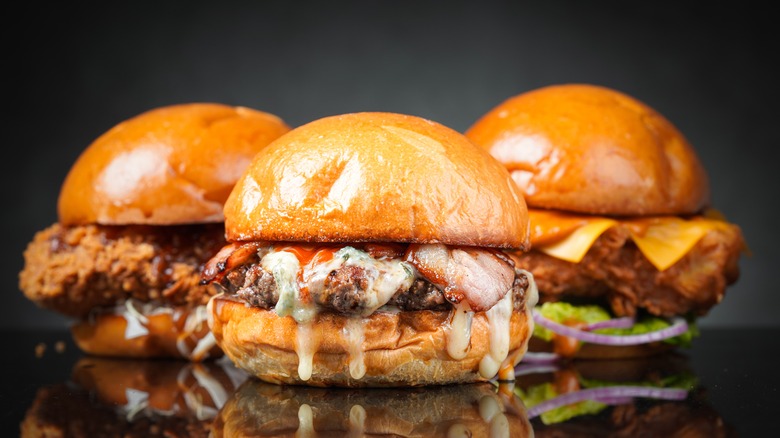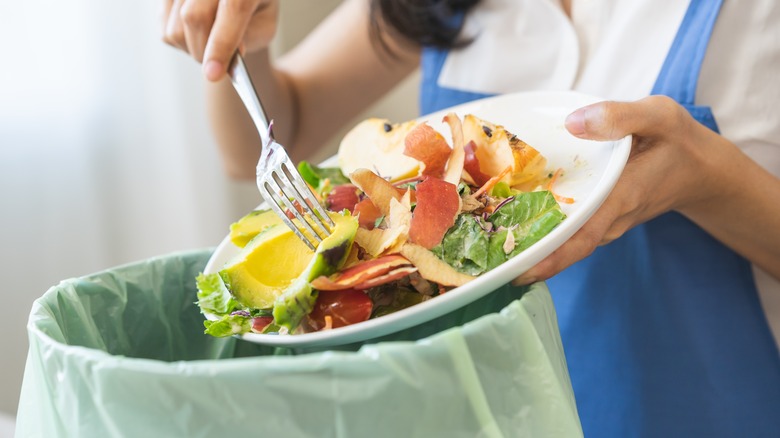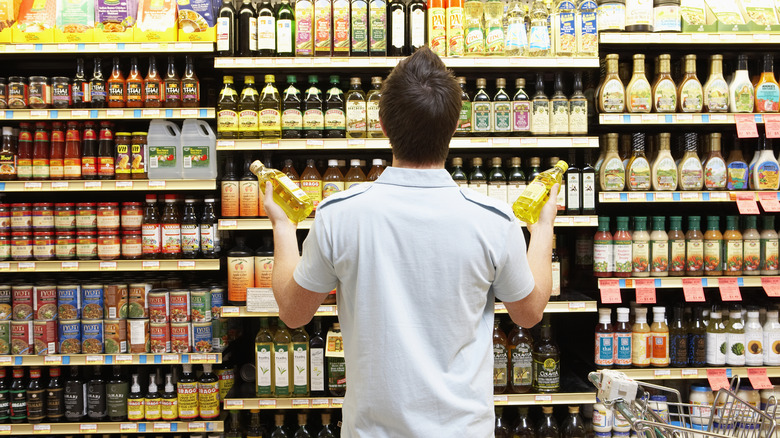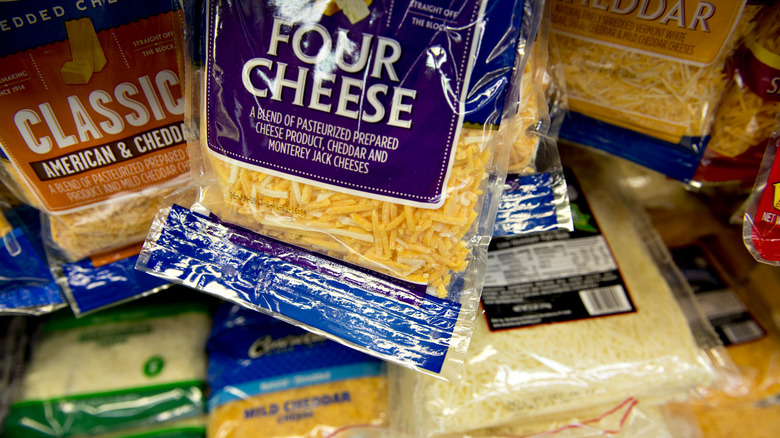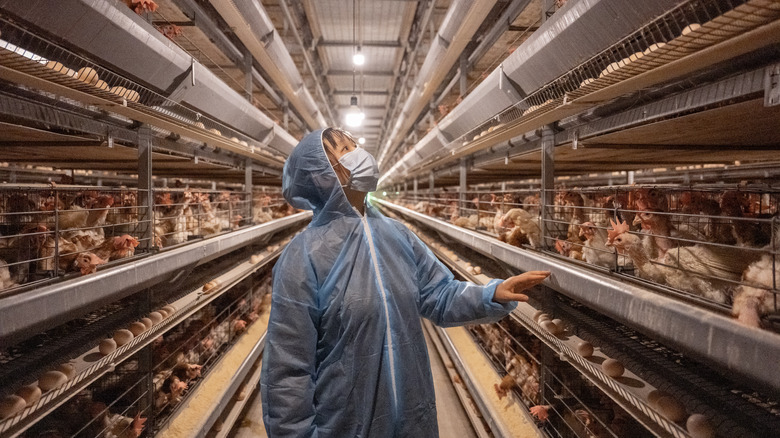12 Startling Secrets About The Food Industry
Food is a big business, with an estimated $2.4 trillion in revenue in the U.S. alone in 2021 (via FoodIndustry.com) and increasing profits every year. By 2028, Statista forecasts that the global food industry will reach a staggering $12.97 trillion in revenue worldwide. The industry is crucial to the daily lives of the nearly 8 billion people it serves and encompasses multiple moving parts. From farms and producers to grocery stores, restaurants, and manufacturers, many people play a vital role in keeping this sector running smoothly.
Since the food industry is so large, the complex processes behind how food goes from its raw state to finished products can be somewhat mysterious. Scientific advancements and innovation frequently coexist with questionable practices and intense controversies, all of which unfold behind the scenes. It's easy to pick products off grocery store shelves or order dishes from restaurant menus, but what's the real story behind your food? Whether you're a diehard foodie or just a curious consumer, the truth may surprise you.
1. Food fraud is incredibly common
Many consumers believe that ingredient labels accurately depict what's in the processed food products they buy, but that isn't always the case. Unfortunately, fraudulent practices in the food industry are rampant. For instance, a farmer was indicted after repeatedly selling seeds fraudulently labeled as organic over five years (via AP News). This issue isn't limited to the United States; The Irish Times reported on a 2013 scandal that rocked the Irish meat-packing industry after beef at three factories was found to contain horse meat. In 2022, 41 people were arrested as part of a criminal enterprise illegally selling horse meat in multiple European markets (via Europol).
The FDA estimates that food fraud costs the global food industry up to $40 billion per year. The primary motivation behind these incidents is increased profit — even at the potential expense of public well-being. For example, food fraudsters sometimes take advantage of world events, including the COVID-19 pandemic, to capitalize on selling subpar food products.
In 2021, The Grocer reported food fraud rose by as much as 37% in some parts of the food industry between 2019 and 2020, per a report released by the Food Authenticity Network. Sadly, as a 2020 Europol publication explains, fear of food shortages at the beginning of the pandemic created a perfect opportunity for criminals to sell questionable products such as low-quality meat and dairy, disguised to meet food safety standards.
2. Some artificial coloring comes from questionable chemicals
Vibrant colors make candy and other treats fun to eat, but some of the chemicals used to create them may be problematic due to their link to potential health issues. This has led to controversy within the food industry, especially in cases where there is conflicting research about an additive's safety for consumption. For instance, Mars faced a lawsuit for using titanium dioxide in Skittles, which the plaintiff claimed was unsafe. Titanium dioxide is present in many food and cosmetic products, and the FDA considers it safe in these applications when used correctly. However, the substance has been banned in Europe due to evidence that it could be carcinogenic.
Although most of the U.S. still allows the use of titanium dioxide in food coloring, California added it along with several other common chemicals to the California Food Safety Act. This act is the first of its kind in the U.S. and bans the sale and production of foods using four additives. In addition to titanium dioxide, the list includes Red Dye No. 3, an additive that has been banned in cosmetics for decades due to its carcinogenic properties but is still legal to use in food.
3. Store-bought orange juice is more processed than you think
Nothing compares to the flavor of fresh-squeezed orange juice, especially not the pre-packaged stuff in stores. Many orange juice brands label their products as pure juice, but that's somewhat misleading. Even the 100% juice varieties undergo a manufacturing process that changes the liquid's natural form. For instance, almost all commercially sold orange juice is also pasteurized to kill bacteria and other potential sources of foodborne illnesses. Although this process makes store-bought orange juice safer to drink, a 2007 study published in the Journal of Food Quality determined that exposing orange juice to high heat during the pasteurization process creates noticeable differences in flavor.
To compensate for this change in taste, orange juice manufacturers typically add flavoring agents to their products. For example, according to the Coca-Cola website, concentrated Minute Maid orange juice has orange oil and orange essence added to give it a more "authentic" flavor before it is packaged. Although these additives are derived from real oranges, they introduce ingredients such as preservatives that aren't present in freshly squeezed juice. These added flavors likely account for why no two orange juice brands taste exactly the same, since each brand hires professionals to curate the additives for its juice.
4. The grill marks on your fast food burger are definitely fake
Many home cooks strive to get the perfect grill marks on a burger, but the food industry doesn't always accomplish this feat the old-fashioned way. Some fast food burgers have enviable grill marks, especially in commercials, but they aren't always genuine. Instead, many companies use char markers and other industrial machines to stamp grill marks onto chicken, burgers, and other food products marketed as "grilled." These machines make it easy to give the impression that food was cooked over an open flame without actually using this method.
However, fake grill marks aren't limited to fast food companies. Frozen food producers also engage in this practice. As Dishworks demonstrates in a TikTok video, food stylists commonly use handheld instruments to add fake grill marks before photographing food. It may seem strange for so many parts of the food industry to use this practice, but the dark lines send an essential message to potential consumers. According to food stylist Claudia Ficca (via Thrillist), companies often use grill marks to convey the unmistakable taste of grilled food to their customers, even if that taste is often the product of additives such as smoke flavoring.
5. The amount of food wasted in America is alarming
America is well-known for its abundantly available food, but a surprising amount of the produce and products made here are never eaten. According to Recycle Track Systems, the U.S. wastes more food than any other country, throwing away almost 60 million tons annually. Unfortunately, there are many sources of waste on the path from farm to table, including crop loss, manufacturing errors, and unnecessary food disposal. As much as 30% of food that makes its way to grocery stores ends up in the trash despite still being fit for consumption.
Luckily, food waste is becoming a hot-button topic that grocery stores and other parts of the food industry are working to address. According to Forbes, initiatives created by supermarkets and other organizations are making a difference in the amount of food Americans throw away. For example, the article highlights Too Good To Go, a company that has created pathways for supermarkets to offer discounts on products that might otherwise become waste.
Many high-profile chefs have also become champions of reducing food waste, using their platforms to inspire positive change in the restaurant industry. For instance, Dan Barber launched a pop-up event called WastED in 2017, showcasing many ingredients that are typically wasted. Italian chef Massimo Bottura helped found Food for Soul, a food waste-focused organization headquartered in Bottura's native Italy and the U.S.
6. Best-by dates are often meaningless
Knowing when food expires helps consumers avoid foodborne illnesses. However, many of the "use by" or "sell by" dates found on processed foods don't accurately depict when these products can be safely consumed. The process of adding these labels to food isn't standardized, leading to inconsistencies and misconceptions. Many consumers equate "sell by" dates with a food's expiration date, but the two are rarely the same. Instead, "sell by" dates are a brand's best guess about how long their products will maintain ideal freshness and flavor. More often than not, products are still perfectly safe to eat after their "sell-by" date. The arbitrariness of "sell by" dates is further exacerbated by the fact that adding these dates to products is largely voluntary in the U.S.
To limit confusion surrounding the meaning of dates printed on food, the Food Safety and Inspection Service (FSIS) requires manufacturers who elect to include "sell by" dates on their products to properly qualify their meanings. The suggested phrasing from the FSIS is "Best if used by," which makes it a little clearer that the date refers to quality rather than safety. Nevertheless, AP News reports that every year, approximately 4 million tons of food waste in the U.S. occurs because of misunderstandings about "sell by" dates.
7. Restaurant background music has a surprising purpose
Music can make any place feel more fun, but there's more to restaurant background music than just atmosphere. Psychological studies show music significantly influences mood, and many restaurants select it accordingly. Uptempo music can make diners feel invigorated, while soft, slow music evokes tranquility. However, customers aren't the only ones who benefit from listening to certain kinds of background music; restaurant staff can also enjoy the mood-elevating effects of music during their shifts. Playing upbeat music can help wait and kitchen staff feel more positive, which can increase productivity.
In addition to impacting mood, ambient music can also affect how quickly guests finish their meals. A 2020 study published in Appetite revealed that slower music influences people to eat leisurely. Therefore, this type of music could be a helpful tool for restaurants hoping to keep guests in their seats longer. The study further explains that even music volume can encourage specific consumption patterns. For example, listening to loud music encourages people to drink more beverages. Theoretically, bars can increase their profits just by cranking up the volume.
8. You can thank wood pulp for keeping your shredded cheese clump-free
Pre-shredded cheese is very convenient to have on hand, but you're not only getting cheese. Most varieties of shredded cheese also contain cellulose, a harmless substance that keeps the strands from clumping together. Although cellulose is abundantly found in plants, a common source for processed foods is wood pulp. The use of cellulose in food started as early as the 1700s, when mills began combining flour with sawdust to cut costs and offset wheat shortages.
The cellulose added to modern foods is generally safer than the sawdust of yesteryear, and the FDA considers it safe for consumption. However, freshly shredded cheese is still a better choice than pre-shredded because of transparency issues. Unfortunately, some cheese manufacturers may bulk up their shredded product with more cellulose, making it difficult to determine how much cheese is really in a package. In some instances, using cellulose to increase the volume has been taken to extremes. In 2016, Bloomberg reported that some parmesan cheese manufacturers were selling products labeled as 100% parmesan that were almost entirely composed of flavored cellulose.
9. Store brands and name brands may be the same
Brand-name products are often considered superior to grocery store private labels, but their quality is more similar than consumers may believe. Many private-label products are manufactured by the same companies that produce brand names, and it's not uncommon for these products to be made in the same factories. In many cases, the ingredients are also nearly identical, making some private-label products almost indistinguishable from their name-brand counterparts.
Overall, the most significant difference between name-brand and store-brand products comes down to price. Depending on the items purchased, consumers can save up to 40% on their grocery bills just by switching to store-brand (via GoBankingRates). Marketing costs are a major factor in brand-name product prices. Advertising these products is a huge expense, costing leading national brands millions of dollars every year. For example, the Kellogg Company spent approximately $756 million on advertising in 2022 alone (via Statista). Since private-label products rarely appear in ads, supermarkets aren't passing marketing expenses on to customers in the form of higher prices.
10. U.S.-raised chicken is banned in other countries
Food that is processed in the U.S. is sometimes subject to international bans due to different food industry policies. This includes U.S.-produced chicken, which has been banned overseas for over two decades. Chicken in the U.S. is washed in chlorinated water to kill bacteria, which helps reduce instances of foodborne illnesses. The process is safe, but Europe banned its import due to animal welfare concerns. The ban argued that the washing process could be used as a substitute for proper hygiene practices during the chickens' lifespans.
Unfortunately, other countries have valid reasons to be concerned about how chickens are raised in the U.S. In 2023, Surge reported that USDA inspectors found hundreds of animal welfare issues in poultry processing centers, including inhumane slaughtering methods. Other problematic living conditions, including overcrowding and limited exposure to natural light and fresh air, also negatively contribute to the health of commercially raised chickens in the U.S.
11. Science is partially to blame for your food cravings
Food cravings may feel random, but there is a wealth of scientific knowledge behind why some foods are enduringly popular. For instance, sugary treats and salty snacks stimulate parts of the human brain associated with rewards, reinforcing our desire to eat them repeatedly. Over time, cravings for specific foods can become long-term habits.
Unsurprisingly, major producers within the food industry apply science-based tactics to make their products nearly impossible to resist, tapping into the biology behind what makes people crave certain flavors. Food industry scientists have used studies about sugar cravings to determine the ideal sweetness for Prego pasta sauce, adding just enough sugar to ensure consumers will want to come back for more. Some of these companies have even obtained patents for certain processed foods and preparation methods to retain control of their innovations.
However, there's more to inspiring cravings than just biology: The food industry also heavily relies on advertising to whet consumers' appetites for their products. Seeing a commercial featuring a beloved snack is a powerful craving trigger for many people. Just like eating the actual food, these commercials stimulate the brain's reward centers and make cravings difficult to ignore.
12. The size of your shopping cart is intentional - and growing
Most people grab a shopping cart at the supermarket's front door without even thinking, and retailers have capitalized on that habit to increase sales. Shopping carts are now approximately three times as large as carts from 1975 (via Slate), and with good reason: larger carts mean larger purchases. As marketing expert Martin Lindstrom explained to Today, doubling the size of a shopper's cart increases the amount of groceries they buy by 40%. Given this statistic, it's easy to see why many supermarkets have embraced this change.
However, grocery stores aren't just focused on the overall size of carts; research into other features has also revealed valuable insights about how carts impact spending habits. For example, the Journal of Business Research published a study in 2017 that showed creating different-sized partitions in shopping carts influenced the types of items consumers purchased. In the study, adding a large compartment for produce encouraged people to buy more fruit and vegetables.
Even the size and position of a cart's handles have become the subject of scientific research in recent years. For instance, a study published in the Journal of Marketing in 2021 explains that the upper arm muscles activated by pushing a cart with a traditional horizontal handle may encourage shoppers to spend less. The article theorizes that replacing the standard bar with handles that are perpendicular to the ground could increase sales by activating muscles that inspire larger purchases.
